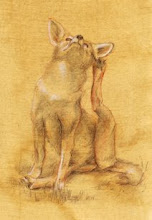
There are several ways that I save whites by using methods to block out parts of the paper. But I really prefer to paint around the whites. I think that it is mainly laziness that motivates me to work that way. The methods used to protect the white of the paper take time and none of them are ideal. Each has its own set of problems and masked areas almost always need to be repainted. The image above shows details from three paintings. The whites were saved by the following methods.
To preserve the whites in the close-up on the left, I masked the ripples in the water and the highlights on the rocks with a liquid frisket or masking fluid. I have used several different brands, but I currently prefer White Mask. The benefits of using a masking fluid is that it can be applied to very small areas. You do need to be careful that the white area is completely covered so that any washes of color do not leave splotches of color where you do not want them. The biggest problem using masking fluid occurs when you remove it. The edges can be harsh and not as clean as you had hoped. Plus the bright white areas look crude and out of place. I always rework the edges and often add tone into the bright white areas.
The dead tree in the middle was blocked with masking tape. I like using masking tape because it is quick and I have become very skilled in tearing and shaping the tape to go around curves and to make complex branches. I also like the sharp strong edges that you get with the tape. But as with the masking fluid you need to be careful and make sure that the tape is covering what you want to keep white. Masking tape can tear the paper when you remove it and wet paint often bleeds under the edges of the tape. Use your fingers to press down the edges of the tape, but make sure that you are either using removable masking tape or make it less sticky. To remove some of the glue on very sticky tape, use it to pick the lint off of your clothing. Press the piece of tape a couple of times onto your jeans and presto you now have removable tape!
To save the whites in the detail on the left, I painted around them. Because I wanted soft edges, it was my only option. You can control where your paint flows by the areas you moisten with clear water for a wash. I left the white areas dry. This meant that my background color flowed into the wet areas, but stopped when it came to the dry paper. I used clear water to soften the edges of the background where it met up with the white areas. When the painting was dry, I laid in very light washes in the white area to suggest the delicate fiber on the milkweed seeds. © Joan Wolbier 2009
